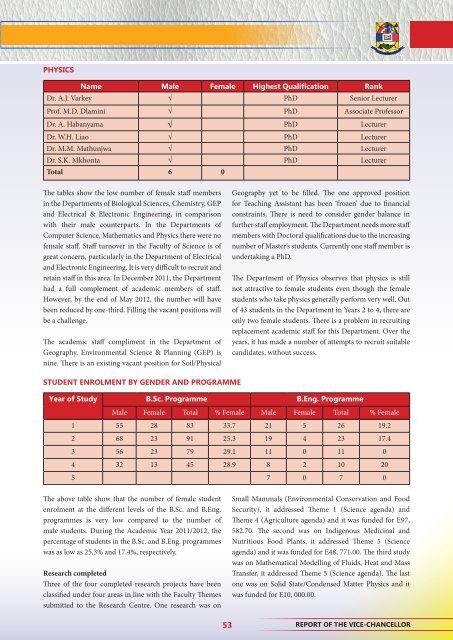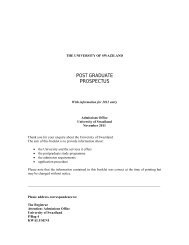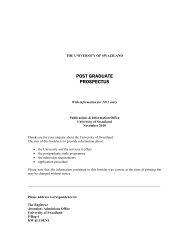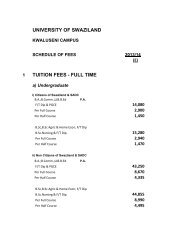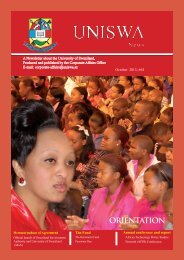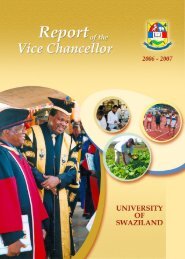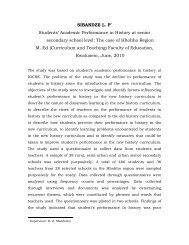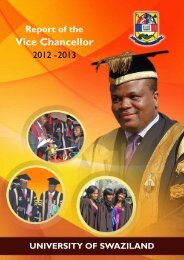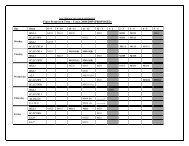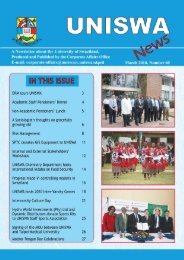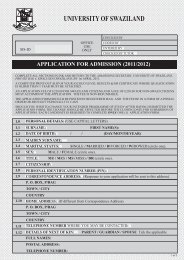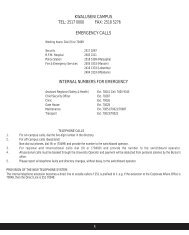CAMPUSES & CENTRES
2011/2012 - University of Swaziland
2011/2012 - University of Swaziland
You also want an ePaper? Increase the reach of your titles
YUMPU automatically turns print PDFs into web optimized ePapers that Google loves.
PHYSICSName Male Female Highest Qualification RankDr. A.J. Varkey √ PhD Senior LecturerProf. M.D. Dlamini √ PhD Associate ProfessorDr. A. Habanyama √ PhD LecturerDr. W.H. Liao √ PhD LecturerDr. M.M. Mathunjwa √ PhD LecturerDr. S.K. Mkhonta √ PhD LecturerTotal 6 0The tables show the low number of female staff membersin the Departments of Biological Sciences, Chemistry, GEPand Electrical & Electronic Engineering, in comparisonwith their male counterparts. In the Departments ofComputer Science, Mathematics and Physics there were nofemale staff. Staff turnover in the Faculty of Science is ofgreat concern, particularly in the Department of Electricaland Electronic Engineering. It is very difficult to recruit andretain staff in this area. In December 2011, the Departmenthad a full complement of academic members of staff.However, by the end of May 2012, the number will havebeen reduced by one-third. Filling the vacant positions willbe a challenge.The academic staff compliment in the Department ofGeography, Environmental Science & Planning (GEP) isnine. There is an existing vacant position for Soil/PhysicalGeography yet to be filled. The one approved positionfor Teaching Assistant has been ‘frozen’ due to financialconstraints. There is need to consider gender balance infurther staff employment. The Department needs more staffmembers with Doctoral qualifications due to the increasingnumber of Master’s students. Currently one staff member isundertaking a PhD.The Department of Physics observes that physics is stillnot attractive to female students even though the femalestudents who take physics generally perform very well. Outof 43 students in the Department in Years 2 to 4, there areonly two female students. There is a problem in recruitingreplacement academic staff for this Department. Over theyears, it has made a number of attempts to recruit suitablecandidates, without success.STUDENT ENROLMENT BY GENDER AND PROGRAMMEYear of Study B.Sc. Programme B.Eng. ProgrammeMale Female Total % Female Male Female Total % Female1 55 28 83 33.7 21 5 26 19.22 68 23 91 25.3 19 4 23 17.43 56 23 79 29.1 11 0 11 04 32 13 45 28.9 8 2 10 205 7 0 7 0The above table show that the number of female studentenrolment at the different levels of the B.Sc. and B.Eng.programmes is very low compared to the number ofmale students. During the Academic Year 2011/2012, thepercentage of students in the B.Sc. and B.Eng. programmeswas as low as 25.3% and 17.4%, respectively.Research completedThree of the four completed research projects have beenclassified under four areas in line with the Faculty Themessubmitted to the Research Centre. One research was onSmall Mammals (Environmental Conservation and FoodSecurity), it addressed Theme 1 (Science agenda) andTheme 4 (Agriculture agenda) and it was funded for E97,582.70. The second was on Indigenous Medicinal andNutritious Food Plants, it addressed Theme 5 (Scienceagenda) and it was funded for E48, 771.00. The third studywas on Mathematical Modelling of Fluids, Heat and MassTransfer, it addressed Theme 5 (Science agenda). The lastone was on Solid State/Condensed Matter Physics and itwas funded for E10, 000.00.53REPORT OF THE VICE-CHANCELLOR


